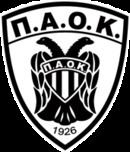Founded 1926 Chairman Thanasis Katsaris | Colours Black, White | |
 | ||
Full name Pan-Thessaloniki Athletic Club of ConstantinopolitansΠανθεσσαλονίκειος Αθλητικός Όμιλος Κωνσταντινοπολιτών Nickname Dikefalos Tou Vorra (Two Headed Eagle of the North) Anthem PAOK, PAOK(Mimis Traiforos Petros Giannakos) | ||
P.A.O.K. (Greek: Π.Α.Ο.Κ., Πανθεσσαλονίκειος Αθλητικός Όμιλος Κωνσταντινοπολιτών, Panthessalonikeios Athlitikós Ómilos Constantinoupoliton, Pan-Thessaloniki Athletic Club of Constantinopolitans), known in European competitions as A.C. PAOK (Α.Σ. Π.Α.Ο.Κ.), is a major multi-sports club in Thessaloniki, Greece. The club is home to several teams, including football, basketball, volleyball, handball, water polo, swimming, wrestling, ice hockey, and weightlifting. PAOK was founded in 1926. Because of its crest, it is also known as the "Two-Headed Eagle of the North", in contrast with AEK, the "Two-Headed Eagle of the South". They are one of the most popular Greek clubs with millions of fans all over Greece (mostly in Northern Greece but not only), such as the Greek diaspora.
Contents
History
P.A.O.K. is the historical continuation of the Hermes Athletic and Cultural Association from the Pera area of Constantinople (present day Istanbul), established by Greek residents of the city in 1875. The need for Constantinople's Greek residents to express and support their Hellenism within Ottoman Turkey was what led to the creation of this club. In 1923, following the failed Greek invasion of Asia Minor and the agreed population swap between Greece and the newly established Turkish Republic, the Greeks of Constantinople renamed their club Pera. The club won many cups and continued to have a strong presence in the sporting sector. However, that situation did not last long. Most players were forced to flee, leaving behind a team, renamed Politakia, consisting of residents of Constantinople. Those who fled settled in Thessaloniki and in 1926 established P.A.O.K., retaining their Greek symbols: the twin-headed eagle of the Byzantine Empire, and black and white for their colors, to symbolize the black of mourning for the tragic story of lost homelands, and white for the hope of a better tomorrow. This club history—stretching back to the 19th century—in effect makes P.A.O.K. one of Greece's oldest athletic clubs, but it also means that it shoulders a heavy historical burden.
The club's first charter was approved on 20 April 1926 by a decision of the Thessaloniki Court of First Instance (No. 822).
The club's founding members were A. Angelopoulos, A. Athanassiadis, K. Anagnostidis, M. Ventourellis, F. Vyzantinos,V.Karapiperis, A. Dimitriadis, D. Dimitriadis, N. Zoumboulidis, M. Theodosiadis, T. Ioakimopoulos, P. Kalpaktsoglou, T. Kartsambekis, D. Koemtzopoulos, K. Koemtzopoulos, P. Kontopoulos, K. Kritikos, M. Konstantinidis, P. Maletskas, I. Nikolaidis, L. Papadopoulos, F. Samantzopoulos, T. Tsoulkas, M. Tsoulkas, S. Triantafyllidis, and T. Triantafyllidis (who was also its first Chairman).
P.A.O.K.'s first Board of Directors, serving between 1926 and 1927, consisted of:
After the club's establishment and two months of preparation, the team began competing against the other teams in Thessaloniki. The desire to see the new team compete led many to the Iraklis Football Ground on 26 July 1925, where the club won 2–1. The first professional contract was signed by the Club on 5 September 1928. The contract stipulated that the footballer Etien, who had come from the Constantinople club Peraclub, would be paid 4,000 drachmas per month. The contract was signed by Dr. Meletiou (P.A.O.K. Chairman) and Mr. Sakellaropoulos, Hon. Secretary. The Syntrivaniou Football Ground was officially opened on 12 December 1930 as a home base. This was followed by a friendly match against Aris with the home team winning 2–1.
Symbols
Created by Constantinopolitans, the new club nevertheless was open to every citizen of Thessaloniki, leading to a minor rivalry with AEK Thessaloniki, the other Constantinopolitan team of the city, in which played only refugees. The original logo of PAOK was a horseshoe and a four-leaf clover.
Finally the two teams were merged in one in 1929. The current one since 1929 is the two-headed eagle. The eagle symbolizes the origins of the club in the former Byzantine capital, Constantinople, and the legacy of the Greek refugees from the Ottoman Empire.
Rivalries
P.A.O.K.'s main rivals are the teams of Olympiacos, Aris, Panathinaikos, AEK, and Iraklis. The biggest rivalry is against Olympiacos and second with arch-rivals Aris. The derby against Olympiacos is the fiercest, representing more than any other, the animosity between Athens and Thessaloniki. The rivalry started in the 1960s when Olympiacos tried, and failed, to sign Giorgos Koudas, one of the best players of his time, from P.A.O.K., through direct negotiations with the player.
Men's football
Women's football
The women's football department has its beginnings in 1984 with the creation of AO Heliopolis. Later in 1996 several players left Heliopolis and created Olympiada 96. Six years later the team had a lot of problems and faced bankruptcy so Olympiada 96 joined PAOK and AS PAOK took over in 2002.
Honours
Honours
Honours
Honours
Honours
Honours
Honours
Honours
Honours
Tae Kwon Do
PAOK became the first club in 2002 with a Tae Kwon Do department. Currently, over 50 active athletes practice daily in Gate 8 in Toumba Stadium.
Noted Athletes
Gallery
Football
Basketball
Volleytball
